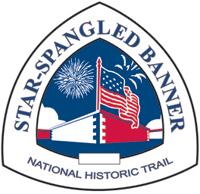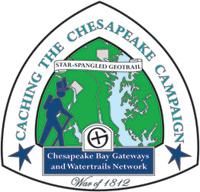SSB - Congressional Cemetery Traditional Geocache
SSB - Congressional Cemetery
-
Difficulty:
-

-
Terrain:
-

Size:  (regular)
(regular)
Related Web Page
Please note Use of geocaching.com services is subject to the terms and conditions
in our disclaimer.
During the first challenge along the Star-Spangled Banner GeoTrail, over 400 first edition SSB geocoins were awarded. We would like to thank everyone who participated in the Star-Spangled Banner GeoTour. We are currently out of geocoins but stay tuned for other opportunities along the Star-Spangled Banner GeoTour!


Come on a journey to remember and commemorate the dramatic chain of events, people and places that led to the birth of our National Anthem.
The story of the Star-Spangled Banner was shaped by the events of the Chesapeake Campaign during the War of 1812. From February 1813 until February 1815, the Chesapeake Bay was the center of a fierce struggle between the British and Americans. Places and landscapes still exist today that provide a touchstone to the past. The trail traces events and related sites that figured prominently in the Chesapeake Campaign of the War of 1812 that have national significance, physical integrity, and the potential for contemporary recreation and interpretation.

You are seeking a traditional hide. Enter the main gate at N 38 52.962 / W 076 58.739, and follow the brick path. The Cemetery gates are unlocked but kept closed as the cemetery doubles as a dog park. Cache hunters should open gate to enter and close behind them to keep dogs inside. Free on-street parking is available along both sides of the streets near the main gate.
Located in Southeast Washington, D.C., overlooking the Anacostia River, Congressional Cemetery is the final resting place of thousands of influential and interesting people. These men and women shaped the early history of the capital city and of the nation. Among those buried in its plots are members of Congress, industrial leaders, architects, diplomats and land developers as well as a large number of individuals who played a role in the War of 1812.
First established by private citizens in 1807 and later given over to Christ Church, Washington Parish, which gave it the name Washington Parish Burial Ground, Congressional Cemetery is widely known for the sandstone cenotaphs that line its pathways. Designed by Benjamin Latrobe, who also served as architect of the Capitol Building, the cenotaphs honor members of Congress who died while in Washington, D.C. The term cenotaph technically refers to any empty tomb, but for the purposes of Congressional Cemetery, the term applies only to these Latrobe-inspired monuments.
The website offers a full list of those buried in the cemetery with a connection to the War of 1812. a few notables include:
Stephen Pleasonton, served as a clerk with the State Department during the War of 1812 and saved the Declaration of Independence and other papers from being burned by British forces during their attack in 1814. Following orders from President James Madison, Pleasonton packed all the Department’s records into several coarse linen bags. This included the original Declaration of Independence, the commission and correspondence of George Washington, the Articles of Confederation, the United States Constitution, and all the treaties, laws, and correspondence of the Department since 1789. He had all of this carted to a grist mill three miles beyond Georgetown. The next day, Pleasonton grew concerned that the British might destroy a cannon foundry located near the mill, thus endangering the records. So, with all due haste, he located more wagons to take the priceless materials another thirty-five miles to Leesburg, Virginia, where they were stored in an empty stone house. That night, the British arrived and burned many buildings in the Washington. However, due to Pleaston’s efforts, many of the Nation’s founding documents were safely ensconsed in rural Virginia.
William Pinkney, served as Attorney General in President Madison’s cabinet during the War of 1812. An ardent supporter of the conflict, he was a major in the Maryland Militia. At the Battle of Bladensburg in August 1814, he fell wounded while leading a company of riflemen. Following the War, he served as Congressman from the fifth district of Maryland from 1815 to 1816, and as a U.S. Senator from Maryland from 1819 until his death in 1822.
Elbridge Gerry, served as Vice-President during the War of 1812. Gerry was also a member of the Continental Congress, a signer of the Declaration of Independence and a delegate to the constitutional convention of the United States held in Philadelphia in 1787. He was elected Vice President of the United States as a Democrat on the ticket with James Madison in 1812 and served from March 4, 1813, until his death in Washington, D.C., on November 23, 1814.
Push-Ma-Ta-Ha, also spelled Pooshawattaha, Pooshamallaha, or Poosha Matthaw, was a chief of the Choctaw people. Highly regarded by American Indians, Europeans and white Americans for his skill in war and diplomacy, Push-Ma-Ta-Ha led a group of several hundred Choctaws to fight on the side of the United States during the War of 1812. In total, Push-Ma-Ta-Ha took part in more than 20 battles and served directly under General Jackson in his Pensacola campaign.

Redemption Chapel 1913
Other notables buried at Congressional Cemetery include more than a dozen Senators, over 60 members of the House of Representatives and Vice-President George Clinton. Also interesting are Tobias Lear, personal secretary to George Washington; Commodore Thomas Tingey, first commandant of the Washington Navy Yard; Robert Mills, architect of the Washington Monument; Matthew Brady, Civil War photographer; Belva Lockwood, first woman to practice law before the Supreme Court; and J. Edgar Hoover, first director of the FBI.

Thanks to WVMuddyBoots for helping with this hide and the Maryland Geocaching Society for assisting with this project!
Additional Hints
(Decrypt)
Gerr jvguva fvgr bs gur Gbgrz Cbyr